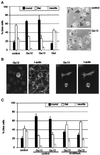Activation of RhoA by lysophosphatidic acid and Galpha12/13 subunits in neuronal cells: induction of neurite retraction
- PMID: 10359601
- PMCID: PMC25381
- DOI: 10.1091/mbc.10.6.1851
Activation of RhoA by lysophosphatidic acid and Galpha12/13 subunits in neuronal cells: induction of neurite retraction
Abstract
Neuronal cells undergo rapid growth cone collapse, neurite retraction, and cell rounding in response to certain G protein-coupled receptor agonists such as lysophosphatidic acid (LPA). These shape changes are driven by Rho-mediated contraction of the actomyosin-based cytoskeleton. To date, however, detection of Rho activation has been hampered by the lack of a suitable assay. Furthermore, the nature of the G protein(s) mediating LPA-induced neurite retraction remains unknown. We have developed a Rho activation assay that is based on the specific binding of active RhoA to its downstream effector Rho-kinase (ROK). A fusion protein of GST and the Rho-binding domain of ROK pulls down activated but not inactive RhoA from cell lysates. Using GST-ROK, we show that in N1E-115 neuronal cells LPA activates endogenous RhoA within 30 s, concomitant with growth cone collapse. Maximal activation occurs after 3 min when neurite retraction is complete and the actin cytoskeleton is fully contracted. LPA-induced RhoA activation is completely inhibited by tyrosine kinase inhibitors (tyrphostin 47 and genistein). Activated Galpha12 and Galpha13 subunits mimic LPA both in activating RhoA and in inducing RhoA-mediated cytoskeletal contraction, thereby preventing neurite outgrowth. We conclude that in neuronal cells, LPA activates RhoA to induce growth cone collapse and neurite retraction through a G12/13-initiated pathway that involves protein-tyrosine kinase activity.
Figures




Similar articles
-
Glycogen synthase kinase-3 is activated in neuronal cells by Galpha12 and Galpha13 by Rho-independent and Rho-dependent mechanisms.J Neurosci. 2002 Aug 15;22(16):6863-75. doi: 10.1523/JNEUROSCI.22-16-06863.2002. J Neurosci. 2002. PMID: 12177184 Free PMC article.
-
Inhibition of lysophosphatidate- and thrombin-induced neurite retraction and neuronal cell rounding by ADP ribosylation of the small GTP-binding protein Rho.J Cell Biol. 1994 Aug;126(3):801-10. doi: 10.1083/jcb.126.3.801. J Cell Biol. 1994. PMID: 8045941 Free PMC article.
-
Dissociation of LPA-induced cytoskeletal contraction from stress fiber formation by differential localization of RhoA.J Cell Sci. 1997 Oct;110 ( Pt 19):2417-27. doi: 10.1242/jcs.110.19.2417. J Cell Sci. 1997. PMID: 9410880
-
Bioactive lysophospholipids and their G protein-coupled receptors.Exp Cell Res. 1999 Nov 25;253(1):230-8. doi: 10.1006/excr.1999.4702. Exp Cell Res. 1999. PMID: 10579925 Review.
-
Regulation of neuronal cytoskeleton by lysophosphatidic acid: role of GSK-3.Biochim Biophys Acta. 2002 May 23;1582(1-3):144-53. doi: 10.1016/s1388-1981(02)00149-x. Biochim Biophys Acta. 2002. PMID: 12069822 Review.
Cited by
-
Mechanisms of adhesion G protein-coupled receptor activation.J Biol Chem. 2020 Oct 9;295(41):14065-14083. doi: 10.1074/jbc.REV120.007423. Epub 2020 Aug 6. J Biol Chem. 2020. PMID: 32763969 Free PMC article. Review.
-
Pediococcus pentosaceus LAB6- and Lactiplantibacillus plantarum LAB12-Derived Cell Free Supernatant Inhibited RhoA Activation and Reduced Amyloid-Β In Vitro.Probiotics Antimicrob Proteins. 2024 Feb;16(1):62-75. doi: 10.1007/s12602-022-10009-7. Epub 2022 Nov 29. Probiotics Antimicrob Proteins. 2024. PMID: 36443559
-
Role of Galpha12 and Galpha13 as novel switches for the activity of Nrf2, a key antioxidative transcription factor.Mol Cell Biol. 2007 Sep;27(17):6195-208. doi: 10.1128/MCB.02065-06. Epub 2007 Jun 25. Mol Cell Biol. 2007. PMID: 17591699 Free PMC article.
-
Galpha12/Galpha13 deficiency causes localized overmigration of neurons in the developing cerebral and cerebellar cortices.Mol Cell Biol. 2008 Mar;28(5):1480-8. doi: 10.1128/MCB.00651-07. Epub 2007 Dec 17. Mol Cell Biol. 2008. PMID: 18086886 Free PMC article.
-
RhoA regulates peroxisome association to microtubules and the actin cytoskeleton.PLoS One. 2010 Nov 8;5(11):e13886. doi: 10.1371/journal.pone.0013886. PLoS One. 2010. PMID: 21079737 Free PMC article.
References
-
- Amano M, Chihara K, Kimura K, Fukata Y, Nakamura N, Matsuura Y, Kaibuchi K. Formation of actin stress fibers and focal adhesions enhanced by Rho-kinase. Science. 1997;275:1308–1311. - PubMed
-
- Amano M, Chihara K, Nakamura N, Fukata Y, Yano T, Shibata M, Ikebe M, Kaibuchi K. Myosin II activation promotes neurite retraction during the action of Rho and Rho-kinase. Genes Cells. 1998;3:177–188. - PubMed
-
- Buhl AM, Johnson NL, Dhanasekaran N, Johnson GL. G alpha 12 and G alpha 13 stimulate Rho-dependent stress fiber formation and focal adhesion assembly. J Biol Chem. 1995;270:24631–24634. - PubMed
-
- de Rooij J, Bos JL. Minimal Ras-binding domain of Raf1 can be used as an activation-specific probe for Ras. Oncogene. 1997;14:623–625. - PubMed
Publication types
MeSH terms
Substances
Grants and funding
LinkOut - more resources
Full Text Sources
Other Literature Sources
Research Materials
Miscellaneous

